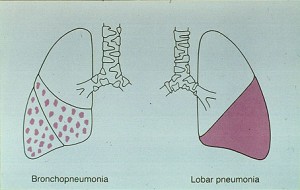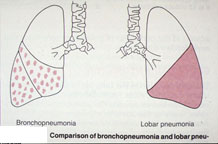Bronchopneumonia is a form of pneumonia that affects millions of individuals around the world every year. Read and know all about the condition, including its various causes, symptoms, diagnosis and treatment options.
Bronchopneumonia Definition
Page Contents
- 1 Bronchopneumonia Definition
- 2 Bronchopneumonia ICD9 Code
- 3 Bronchopneumonia Incidence
- 4 Bronchopneumonia Symptoms
- 5 Bronchopneumonia Vs Lobular Pneumonia
- 6 Bronchopneumonia Causes
- 7 Bronchopneumonia Pathophysiology
- 8 Bronchopneumonia Risk Factors
- 9 Is Bronchopneumonia Contagious?
- 10 Bronchopneumonia Diagnosis
- 11 Bronchopneumonia Treatment
- 12 Bronchopneumonia Complications
- 13 Bronchopneumonia Prognosis
- 14 Bronchopneumonia and Mortality
- 15 Bronchopneumonia Prevention
- 16 Famous People with Bronchopneumonia
- 17 Bronchopneumonia in Dogs
- 18 Bronchopneumonia Pictures
Bronchopneumonia refers to a severe inflammation or swelling of the walls of the bronchioles. Although it us similar to ordinary pneumonia, is can be more acute in nature and need different type of medical treatment. This inflammatory condition of the lungs spreads from and after bronchial infection.
The condition is also known by other names like:
- Bronchogenic pneumonia
- Bronchial pneumonia
The disorder is bilateral and affects a single lobe or multiple lobes.
Bronchopneumonia ICD9 Code
The ICD9 code for this disease is 485.
Bronchopneumonia Incidence
Pneumonia, including Bronchopneumonia, is fairly common in nature and affects millions of individuals only in the United States. Globally, it affects many more people with the disorder having a greater prevalence in third world nations.
Bronchopneumonia Symptoms
The typical signs and symptoms of this disorder include:
- Chest pain
- Chills
- Cough
- Fatigue
- Fever
People suffering from this type of pneumonia may cough up yellow or blood-streaked mucus.
The disorder is more common in older individuals and arises along with other viral respiratory conditions such as Bronchitis. It develops as a complication of asthma.
The early symptoms of the disorder resemble that of flu. In the later stages, the condition can show a progression with patients suffering from problems like:
- Fluctuating chest pain
- Muscle pain
- Shortness of breath
- Unexplained fatigue
In the event of any of these symptoms, sufferers should get in touch with a professional medical care provider on an immediate basis.
In bronchopneumonia, there is an accumulation of liquids such as pus in both the lungs of patients. This can result in reduced supply of oxygen to all the vital organs of the body and acute respiratory difficulties for sufferers. If left without treatment, it can obviously lead to death.
If Bronchopneumonia arises 2-3 days after acute bronchitis, the following health issues are usually experienced:
- Breathlessness
- Central cyanosis
- Increase in pulse rate
- Increase in rate of respiration
- Rise in body temperature
Usually, there is an acute cough with purulent sputum. In this condition, unlike in pneumococcal pneumonia, pleural pain is rare.
Bronchopneumonia Vs Lobular Pneumonia
Bronchopneumonia is different from Lobular Pneumonia. Only one of the two lobes is affected in lobar pneumonia, whereas both lobes suffer from an inflammation in bronchial pneumonia. In Lobular pneumonia, a subdivision or an entire section of the lung may be swollen. In Bronchopneumonia, only patches in and around the tiny passages and airways are inflamed.
However, the external symptoms of both types of Pneumonia are similar in nature, such as fever, chest pain, blood-streaked mucus, respiratory difficulties and chills.
Bronchopneumonia Causes
The disorder may arise as a secondary complication of some other disorder, such as:
- Malnutrition
- Some major operation
- Vomiting or aspiration of food
- Viral infection, such as measles or influenza
- Blockage of bronchus by some neoplasm or foreign body
- Inhalation of poisonous gases
- Hipostatics, lying long after suffering a stroke
- Acute chronic disorders such as Tuberculosis
In the majority of cases, the condition develops due to descending infection of the bronchi. Inflammatory foci of varying sizes develop in the lung parenchyma, which comprise of purulent exudates when bacteria is the cause. These sections are firm and grayish in appearance. They could be great in number or merge between each other (Confluent pneumonia).
Bronchopneumonia Pathophysiology
Bacteria are responsible for the transmission of Bronchopneumonia. The disorder arises when bacteria enters the lungs. Pseudomonas aeruginosa and Staphylococcus aureus are the most common forms of bacteria that lead to the development of bronchial pneumonia. When the pulmonary lobes are infected by bacteria, mucus produced by the lungs fills the alveolar sacs. This in turn results in a condition known as consolidation which happens when the air space is reduced due to the buildup of mucus inside the lungs. Reduced air space leads to respiratory difficulties such as causes shallow (labored) breathing or shortness of breath.
Bronchopneumonia Risk Factors
Senior citizens over the age of 65 years are most susceptible to this disorder. Individuals with long-term ailments that weaken the natural immunity of the body are also prone to this form of pneumonia. Impaired defense capability of the respiratory tract and low body resistance are the main reasons for the development of the condition in such people.
Is Bronchopneumonia Contagious?
This condition is caused by microbial organisms, such as bacteria. Naturally, it is contagious in nature and can be passed on from one person to another.
Bronchopneumonia Diagnosis
Physicians usually diagnose this condition by listening to the breathing sounds of sufferers with a stethoscope. In some cases, the following exams are also used to detect this disorder:
- Complete blood count (CBC)
- Sputum culture test
- Chest x-ray
In some individuals, a CT scan may be conducted. A pleural fluid culture of the fluid around the lungs may be taken.
In case the diagnosis is unclear, lung x-rays should be conducted. It must be remembered that auscultation and lung percussion penetrates up to a depth of 5 cm. Due to this reason, a negative result in an examination does not exclude atypical pneumonia.
In bronchopneumonia patients, an x-ray examination of the chest often helps show a scattering of heterogenous opacities, as opposed to the homogenous opacity that characterizes lobar pneumonia. This happens as a result of involvement of more than one area in the lungs.
Bronchopneumonia Differential Diagnosis
The differential diagnosis of Bronchopneumonia aims at distinguishing its symptoms from those of similar disorders, such as:
- Asthma
- Bronchiectasis
- Chronic Obstructive Pulmonary Disorder (COPD)
- Lung cancer
- Pulmonary edema
- Pulmonary emboli
Doctors should make sure that the symptoms experienced by sufferers are those of Bronchopneumonia and not of any of the conditions mentioned above. A misdiagnosis can jeopardize the health of sufferers and complicate the condition to a severe extent. Due to this reason, patients should always get themselves diagnosed by professional healthcare providers.
Bronchopneumonia Treatment
Upon diagnosis, most sufferers are treated with antibiotics at home. As Bronchopneumonia is an infection caused by bacteria, antibiotics like erythromycin or amoxicillin may used to hasten recovery. Apart from being administered antibiotic medications, patients are advised to consume lots of fluids and have enough rest.
Hospitalization is not deemed as necessary unless the symptoms are acute in nature or there are underlying health issues or other complications such as increased age.
Bronchopneumonia Complications
The typical complications associated with this disorder include the following:
- Acute renal insufficiency in dehydration
- Recurrent pneumonia, that affects other lung sections
- Pleura damage, caused by Pleural empyema, Pleural effusion or Pleurisy
- Cardiovascular disease
- Chronic pneumonia
- Respiratory deficiency
- Thromboembolic complications, due to bed rest
- Septic distribution to the pneumonia agents in blood along with the occurrence of endocarditis, otitis, brain abscess and meningitis.
Bronchopneumonia Prognosis
On strict adherence to the treatment plan prescribed by doctors, the disorder usually resolves within a period of 4-6 weeks. However, individual cases tend to vary on factors like:
- Acuteness of the infection
- The overall health of sufferers
- Age of sufferers
Sufferers may begin to feel better within 3-4 days after the initiation of medical treatment. However, they should follow the orders of their physicians for resuming work and day to day activities.
If an individual has an acute case of Bronchopneumonia or suffers from dehydration, he or she may be hospitalized. In a hospital setting, the condition can be monitored more closely. With proper treatment, the majority of patients manage to recover completely in around 2 weeks. Very elderly or infirm individuals who do not receive proper treatment can die as a result of the disorder.
Bronchopneumonia and Mortality
The rate of mortality is higher at the extremes of life particularly in cases where the condition supervenes or emphysema, chronic bronchitis or any debilitating disorder.
Bronchopneumonia Prevention
Certain vaccines are available that can help prevent bacteria and disorders that can act as causative factors for Bronchopneumonia. The Flu vaccine prevents pneumonia and other viral conditions caused by influenza viruses. A Pneumococcal vaccine like Prevnar and Pneumovax prevents Streptococcus pneumoniae. In children, the Hib vaccine helps prevent pneumonia from the Haemophilus influenza type b.
The best way to prevent the disorder involves washing the hands frequently with soap and water, particularly after coming back from public places or after using the bathroom. Cessation of smoking can also help lower the risk of suffering from pneumonia. Proper amounts of rest and a healthy diet can keep the immune system strong and help in fighting off bacteria and germs that can lead to pneumonia.
Famous People with Bronchopneumonia
The condition has been reported in many famous individuals. Those who have died due to this disorder include famous names such as:
- King Edward VI
- Gregory Peck
- Devin McKinnon
- Rosalind Franklin
Bronchopneumonia in Dogs
In dogs, the disorder occurs as a result of inflammation of the lungs and the bronchi – the large passages that help move air into the lungs. The condition generally occurs due to bacterial infection spread by inhalation. The form of pneumonia that is spread through blood contact is less common and frequently more difficult to cure.
Bronchopneumonia Pictures
The following images show the appearance of lungs affected by this condition.
Picture 1 – Bronchopneumonia
Picture 2 – Bronchopneumonia Image
If you suspect yourself or any member of your family to be affected by this disorder, get in touch with a doctor immediately and seek medical treatment promptly. Early diagnosis and treatment will not only ensure a faster recovery from the disease but also help avoid any possible complications that may arise at at any time in future.
References:
http://www.wisegeek.com/what-is-bronchopneumonia.htm
http://voices.yahoo.com/what-bronchopneumonia-111767.html?cat=70
http://nikon2.magnet.fsu.edu/galleries/pathology/bronchopneumonialarge.html
http://en.wikipedia.org/wiki/Bronchopneumonia


